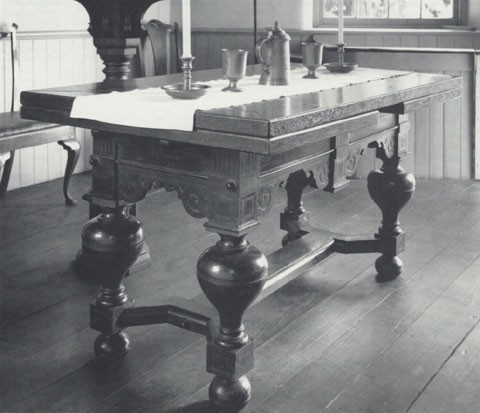
Draw table, Dutch, 1660–1680. Oak and ebony. H. 32 5/8"; top: 36" x 59 3/4" (closed). (Courtesy, Old Dutch Church, North Tarrytown, New York; photo, Gavin Ashworth.)
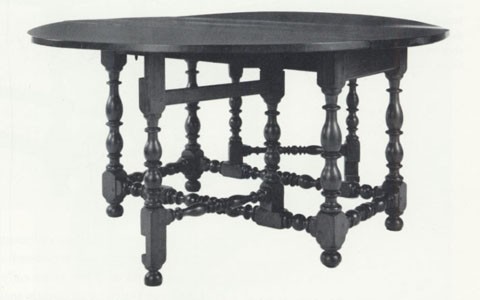
Oval table with falling leaves, New York City, 1700–1730. Mahogany with maple and yellow poplar. H. 30 1/8"; top: 58" x 72 1/4" (open). The table may originally have belonged to Philip Van Cortlandt (1683–1748) and his wife Catherine De Peyster (1688–1766?) who were married in 1710. (Courtesy, Historic Hudson Valley, Tarrytown, New York; photo, Gavin Ashworth.)
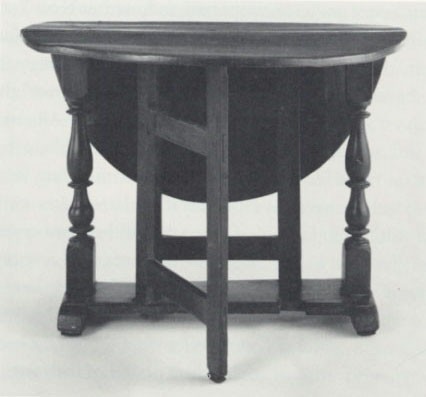
Oval table with falling leaves, New York, 1720–1750. Red gum with yellow poplar. H. 28 1/2"; top: 35 1/2" x 45 1/2" (open). Branded twice on the underside of the stretcher are the initials ATB (conjoined), which may stand for Abraham Ten Broeck of Albany (1734–1810), an owner, not a maker. (Collection of Peter Eliot; photo, Gavin Ashworth.)

Oval table with falling leaves attributed to the Elting-Beekman shops, Kingston, New York, 1700–1730. Red gum and maple with pine and oak. H. 28 1/2"; top: 48 1/2" x 58" (open). The table was purchased by its current owner out of an old Hurley, New York, home. It retains its original top, although its far leaf is off and not included in this photo. The exaggerated shape on the edge of the thick top is characteristic of this shop tradition. (Private collection; photo, Gavin Ashworth.)
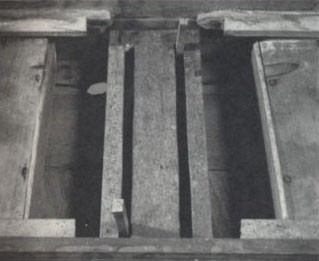
Detail of the draw-bar track on the table illustrated in fig. 10. Pegs that are rectangular in section and inserted in the draw bar at an angle slightly less than 90 degrees are typical of tables attributed to the Elting-Beekman shops. (Photo, Gavin Ashworth.)

Detail of the draw bar on the table illustrated in fig. 4. A prominent feature of the draw bars on tables by the Elting-Beekman shops are cut fingerholds. (Photo, Gavin Ashworth.)

Oval table with falling leaves, Southern New York or Northern New Jersey, 1701–1730. Walnut with cherry and sweet gum. H. 26"; top: 38 7/8" x 43 1/2" (open). (Digital file, ©The Art Institute of Chicago, gift of the Antiquarian Society through the Mr. and Mrs. William Y. Hutchinson Fund, acc. 1985.241. All rights reserved.)
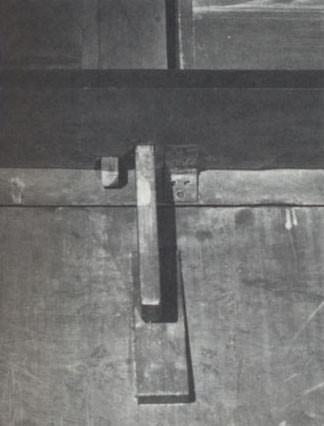
Detail of the draw bar and boxlike draw-bar guide inside the frame of the table illustrated in fig. 7. (Photo, Art Institute of Chicago.)
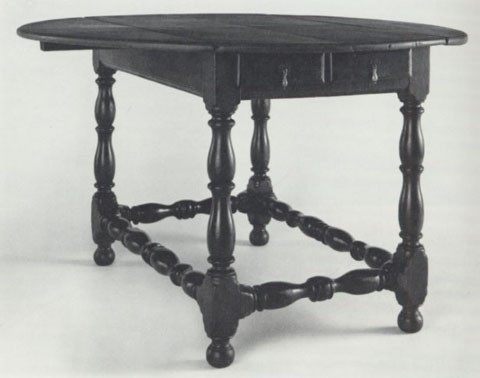
Oval table with falling leaves, New York, 1700–1720. Cherry with maple. H. 27 1/2"; top: 44 1/2" x 47" (open). The smallish top, which is original, was affixed originally by long iron rivets that passed all the way through the aprons and were covered by face-grain plugs in the top. The drawer pulls have their original, late Jacobean-style cast backplates. (Collection of Peter Eliot; photo, Gavin Ashworth.)
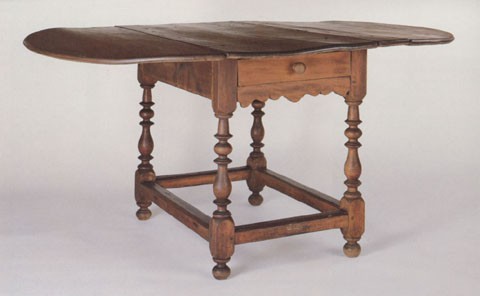
Oval table with falling leaves, attributed to the Elting-Beekman shops, Kingston, New York, 1740–1770. Red gum with pine and oak. H. 28 1/8"; top: 50" x 60 3/8" (open). This is the only table with end drawers attributed to the Elting-Beekman shops. The draw-bar track inside the frame usually discouraged this feature. (Courtesy, Huguenot Historical Society, New Paltz, New York; photo, Gavin Ashworth).
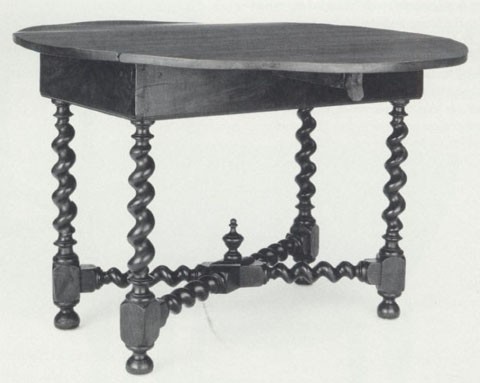
Oval table with falling leaves, New York City, 1690–1730. Red gum with yellow poplar and pine. H. 29 3/8" (minus top); frame 20 3/8" x 35 7/8". The top and finial on the crossed stretchers are modern replacements. The graining on the aprons and lower leg blocks probably dates to the early- to mid-nineteenth century. (Private collection; photo, Gavin Ashworth.)

Oval table with falling leaves, New York City, 1680–1710. Walnut with pine. H. 28 1/2"; top: 42 3/4" x 19" (center section only). The leaves, finial, and possibly the feet are modern replacements. (Courtesy, Winterthur Museum, acc. 59.5.)

Detail of the single-twist leg on the table shown in fig. 11. The leg tapers from a diameter of 2 5/8" at the ring on top of the bottom block to 2 1/8" at the top ring. The upper reel on the leg is skillfully diminished in proportion to the taper. (Photo, Gavin Ashworth.)
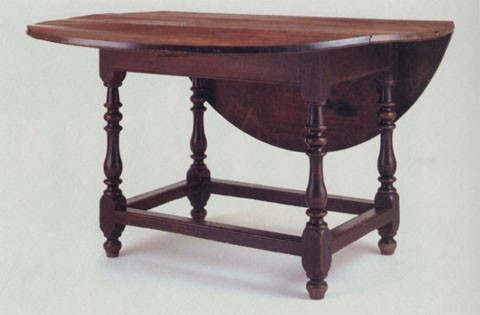
Oval table with falling leaves, attributed to the Elting-Beekman shops, Kingston, New York, 1770–1800. Red gum with yellow poplar and pine. H. 28 1/2"; top: 48 1/2" x 58" (open). This table has a history of ownership in the Vanderlyn family of Kingston and is in a remarkable state of preservation, retaining nearly the full original height of its feet. (Courtesy, Senate House State Historic Site, Kingston, New York; photo, Gavin Ashworth.)
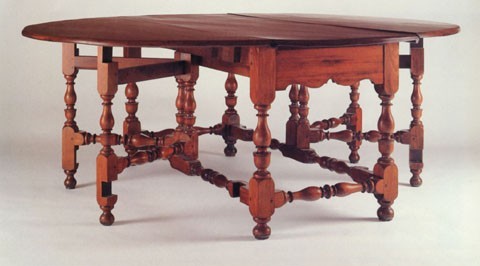
Oval table with falling leaves, unidentified New York cabinetmaker, 1749–1763. Mahogany, sweet gum, yellow poplar and eastern white pine. H. 29 1/2"; top: 71" x 78 1/2" (open). (Albany Institute of History and Art, Gift of the heirs of Major-General John Tayler Cooper; photo, Gavin Ashworth.)

Oval table with falling leaves, New York, 1690–1730. (Wallace Nutting, Furniture Treasury [Framingham, Mass. 1928], 1: no. 943; current location unknown.)

Oval table with falling leaves, New York, 1690–1730. Cherry with yellow poplar. H. 27 1/2"; top: 47 1/2" x 36 1/8" (open). This table and the one in fig. 9 have lambs’ tongues carved on the corners of their leg blocks. The reserve area on the face of the leg blocks are in the shape of baroque ogee arches as a result of this decorative carving. The moldings run on the flat gates are similar in scale and profile to the applied single-arched moldings on early high chests and other case furniture. (Courtesy, Wadsworth Atheneum, gift of J. Pierpont Morgan, acc. 1926.492.)
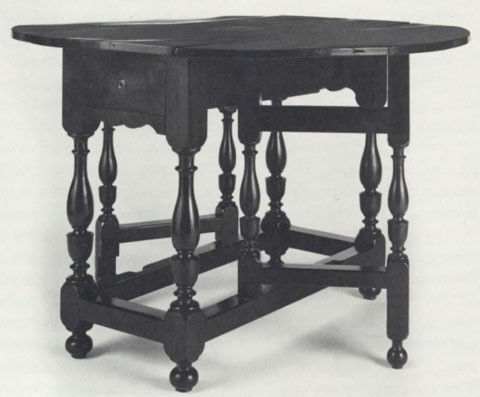
Oval table with falling leaves, New York City, 1690–1720. Mahogany with maple, yellow poplar, and oak. H. 28 7/8"; top: 40 3/4" x 44 1/2" (open). (Courtesy, Museum of the City of New York, gift of the Reynal family; photo, Gavin Ashworth.)
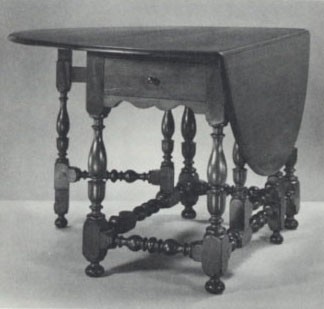
Oval table with falling leaves, New York City, 1700–1740. Mahogany with yellow poplar and oak. H. 28 3/8". Except for the use of turned versus plain stretchers, this table is nearly identical to the example illustrated in fig. 18 and is probably by the same hand. The top appears to be a modern replacement. (Courtesy, Colonial Williamsburg Foundation.)
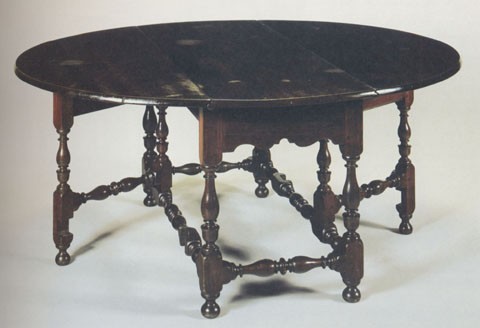
Oval table with falling leaves, New York City, 1740–1760. Mahogany. H. 28 1/2"; top: 53" x 67" (open). This is a considerably smaller version of the Sir William Johnson table (fig. 17). (Private collection; photo, Christie’s).

Oval table with falling leaves, possibly Flushing, New York, 1690–1730. Cherry with pine. H. 27 3/8"; top: 45" x 61" (open). This table and three carved-top Boston leather chairs (one of which is illustrated here) were given to Washington’s Headquarters by the Verplanck family between 1858 and 1872. A dressing table discovered in Flushing, Long Island, with closely related turnings, possibly by the same shop or school of makers, is illustrated in Jonathan L. Fairbanks and Elizabeth Bidwell Bates, American Furniture 1620 to the Present (New York, 1981), p. 65. (Courtesy, New York State Office of Parks, Recreation and Historic Preservation, Washington’s Headquarters State Historic Site, Newburgh, New York; photo, Gavin Ashworth.)

Oval gate-leg table with falling leaves, New York, 1690–1730. Red gum, maple, H. 26 1/4"; top: 30" x 34 3/4" (open). (Courtesy, The Metropolitan Museum of Art, gift of Mrs. Eleanor G. Sargent, 1980, acc. 1980.499.1; All rights reserved, The Metropolitan Museum of Art.)
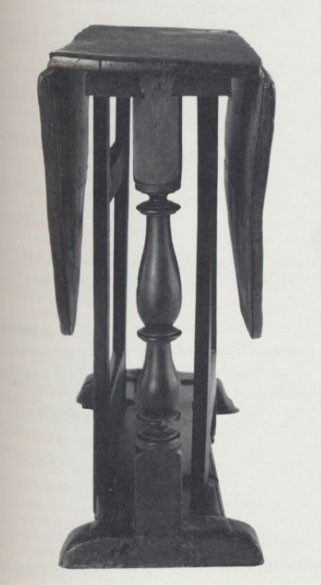
End view of the table in fig. 3 showing the typical heavy dovetail joinery at the top of the upright where it connects to the thick board that supports the top. (Photo, Gavin Ashworth.)

Oval table with falling leaves, New York, 1720–1750. Red gum. H. 28 1/4"; top: 33" x 39 1/2" (open). This trestle-base table with flat gates differs from the two other illustrated examples in that its turned uprights are tenoned up into a cross piece at the top rather than dovetailed to a thick board. The severe warp in the top is typical of flat-sawn red gum, a notoriously unstable wood. (Colonial Williamsburg Foundation.)

Cane armchair, England, 18th century, ca. 1685-1689, walnut. 57 x 30 3/4 x 19 3/4 in. (Courtesy, The Metropolitan Museum of Art, John Stewart Kennedy Fund, 1918, acc. 18.110.18, All rights reserved, The Metropolitan Museum of Art.)

Detail of a leg from the Van Cortlandt family table (fig. 2). (Photo, Gavin Ashworth.)
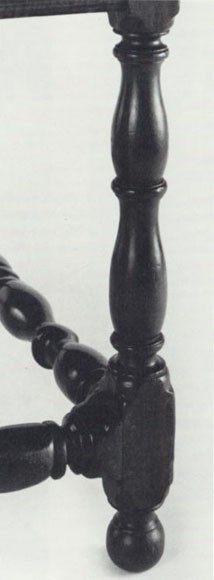
Detail of a leg from the table illustrated in fig. 9. The ball-shaped foot is a modern replacement as are most of the lamb’s tongue carvings on the lower corners of the bottom leg block. (Photo, Gavin Ashworth.)
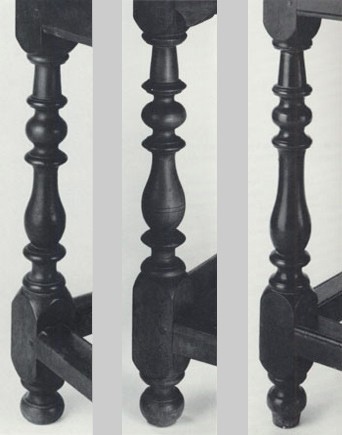
Composite detail of legs from tables attributed to the Elting-Beekman shops at Kingston; left (fig. 4), center (fig. 10), right (fig. 14). (Photo, Gavin Ashworth.)

Composite detail of urn-and-baluster turned legs; left (fig. 18), center (fig. 21), right (fig 15). (Photo, Gavin Ashworth.)
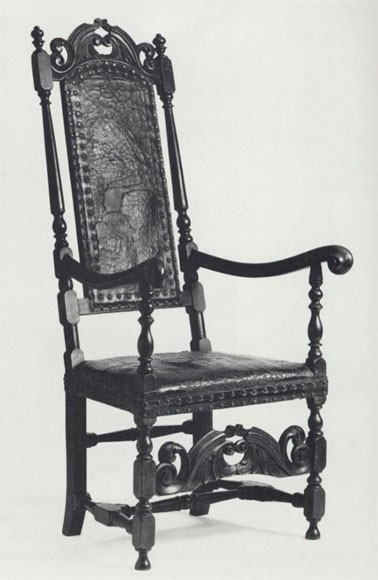
Carved-top leather armchair, Boston, Massachusetts, 1695–1710. Maple and red oak. H. 53 1/4". (Courtesy, Winterthur Museum, acc. 58.553.)
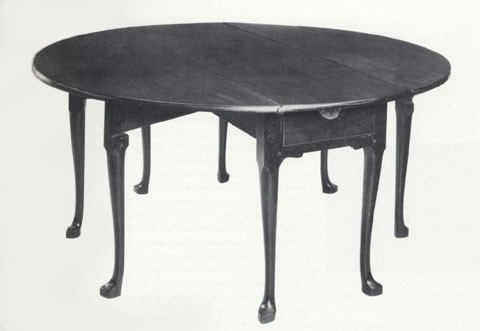
Oval table with falling leaves, New York City, 1735–1765. Mahogany. H. 28"; top: 61" x 65 1/4" (open). Representing a later phase of the baroque style in New York City tables, this example is approximately contemporary with Sir William Johnson’s table (fig. 15) and shares its use of mahogany and barrel-like rule joints. The cyma curves cut into the ends of the rail appear to be segments of the sweeping, cyma and half-round cutout shapes on the Johnson table drawer fronts. (Courtesy, Bernard & S. Dean Levy Inc., N.Y.C.; photo, Helga Studio.)

Detail of a wrought iron dovetail hinge on the table illustrated in fig. 18. (Photo, Gavin Ashworth.)
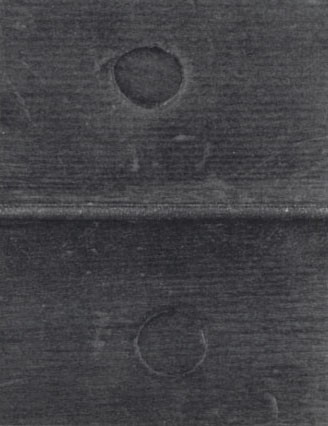
Detail of the face-grain plugs that cover the countersunk rivet heads on the top of the table illustrated in fig. 10. (Photo, Gavin Ashworth.)

Detail of the drawer from the table illustrated in fig. 10. (Photo, Gavin Ashworth.)
